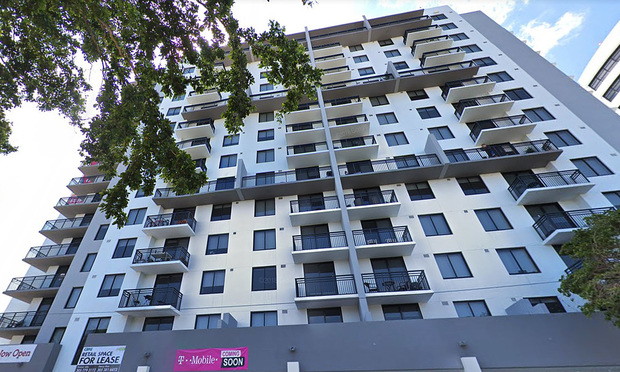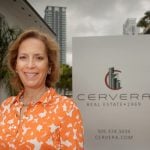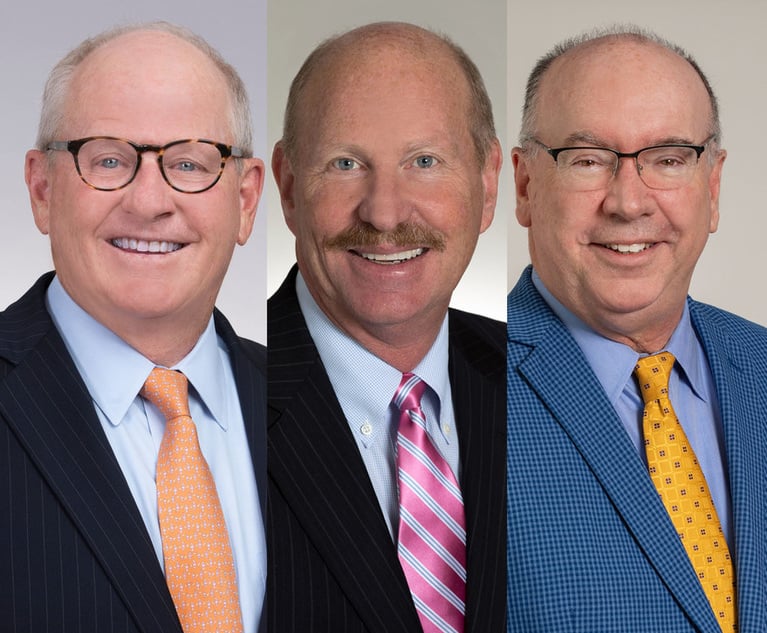South Florida Multifamily Market Trending Toward Apartments After Years of Condo Focus
As multifamily demand has shifted to apartments, some condominiums have been converted to apartments.
September 24, 2018 at 06:00 AM
8 minute read
 1900 SW Eighth St., Miami. Credit: Google
1900 SW Eighth St., Miami. Credit: Google
Across South Florida, sales of apartment buildings dipped this year — yet multifamily remains one of the strongest property types, a market study found.
Just how strong? Some condominiums were converted to apartments, in large part a response to the demand, experts said.
 Brian Hart.
Brian Hart.“As the market was evolving, some are saying, 'Hey, a better return on investment would be luxury rentals as opposed to condominiums.' It all comes down to return of investment,” said Brian Hart, a Carlton Fields shareholder in Miami.
InTown is a 312-unit apartment development at 1900 SW Eighth St. in Miami's Little Havana. Originally planned as a condominium, developer Astor Cos. in November 2016 sold the twin 15-story buildings as apartments for $89 million to property manager Greystar.
Astor originally wanted to sell units to people who wanted to live close to the costlier Brickell District, said Leonardo Caraballo, Astor's attorney for the Greystar sale.
“I think it's associated with a very hot multifamily market, and you had a buyer who was willing to pay a great price per unit,” said Caraballo, a partner at Rennert Vogel Mandler & Rodriguez in Miami.
The price for the Intown apartments worked out to $285,256 per unit.
Drive west along Eighth Street and you'll reach the site of the planned 20-story, 492-unit University Bridge Residences student housing, also originally planned as a condominium. Developer University Developments in March said it's switching to multifamily because keeping ownership of the building was the better scenario in the long run.
University Bridge, which is across the street from Florida International University, is set for completion in the 2020-2021 academic year.
 Alicia Cervera Lamadrid.
Alicia Cervera Lamadrid.Cervera Real Estate managing partner Alicia Cervera Lamadrid worked on University Bridge condo sales, realizing 150 unit sales, according to a news release. She said condo-to-apartment conversions are rare.
The biggest hurdle is getting everyone to agree to sell to the apartment owner. In the world of conversions, switching from apartments to condos was popular before the housing crash.
In Broward County, the 1980s-built, garden-style Jasmine at Tamarac condominiums at 8650 NW 61st St. was converted last spring to the 291-unit 72 West Apartments.
The upswing in the multifamily market is prompting investors to do such switches because they get more value from a rental property, said Charles Brecker, a Saul Ewing Arnstein & Lehr partner who worked the 72 West deal.
“Most developers feel that that's where the best bang for the buck is, so to speak, given the great conditions,” Brecker said.
Investors might be making long-term plans to hold an asset for five to 10 years when, because of the healthy market, they can sell for 30 to 60 percent more than the price they paid, Brecker added, although he spoke in general terms and not specifically about 72 West.
Indeed, the appetite for multifamily investments isn't fueled only by renters, Cervera Lamadrid said.
“We also have institutional demand. We were a city that traditionally was not owned by institutions. It was owned by individuals,” she said. “As the city has become more of a major player, then these institutions have come in, and they want to own more of the city.”
MARKET OVERVIEW
While multifamily sales in the first half of the year slowed compared with the same time in 2017 and 2016, the asset class remained the most transacted commercial property type in South Florida, according to a Cushman & Wakefield report released in September.
Across the region there were 133 sales, half the number in 2016 and 5 percent less than in 2017, yet that's still a lot.
“Although sale activity slowed, it still represents the third highest level of activity ever recorded in the first half of any year,” according to the midyear multifamily market report.
The most sales at 63 were in Miami-Dade County, while Broward had 37 and Palm Beach County had 33.
Other market metrics for the first half of the year remained strong. Net absorption in each county exceeded deliveries, and demand is expected to continue outpacing supply for the next five years, according to the report.
In Miami-Dade, more than 2,000 units were rented in the first half of 2018, about double the amount delivered; in Broward, nearly 2,500 were rented, yet just over 1,000 were built; and in Palm Beach, more than 1,500 were rented, but slightly fewer than that were built, according to the report.
Healthy demand is in part because of net in-migration to South Florida, changing attitudes toward homeownership and high prices for luxury condos, according to the report and market experts.
“One, condo prices, among other things, are pretty high, so it's too expensive to buy for some people,” said Neisen Kasdin, Akerman's Miami office managing partner. “I also think it's a generational preference. I think millennials really don't want to be tied down to one piece of real estate, so they would rather rent than buy. I think it's both.”
South Florida for years has been a magnet for newcomers, and that's projected to continue. But even with more multifamily projects on tap, it remains unclear if supply will keep up.
A net population increase of 550,000 people in expected in South Florida over the next five years, meaning the region would need more than 64,000 new apartments — but only 18,215 are being built, according to the Cushman & Wakefield report.
By the end of 2019, 62 apartment buildings will be finished. The 330-unit Soleste Blue Lagoon at 5375 NW Seventh St. south of Miami International Airport and the 297-unit Modera Edgewater at 411 NE 24th St. in Miami, are among 30 projects set to add 9,837 units in Miami-Dade County.
The 329-unit 790 E Broward is among 21 projects that will add 6,191 units in Broward County, and the 290-unit apartment tower at downtown West Palm Beach's Brightline train station is among 11 projects that will add 2,911 units in Palm Beach County.
REAL ESTATE CYCLE
As the multifamily market has tightened, the heavily built condo market has softened, experts said.
There's been a barrage of condos — in particular luxury units prices art $1 million and up. Even with multifamily demand, some submarkets could be getting saturated with condos. This unfavorable tip in the supply-demand balance could spell the end of the cycle.
“We had a pretty strong (condo) run here, and if things start to overheat on appreciation and building then, yes, there could be a correction,” Hart said. “Everybody senses things will be really robust at least through 2019, and maybe in 2020 we will start to see some of these factors.”
Kasdin, like Hart, also sees the residential cycle resetting after 2020.
Condo construction peaked in 2016, triggering an inventory buildup, Kasdin added.
Perhaps no other metric illustrates an oversupply better than one showing how long it would take to sell off the available supply.
 Ronald A. Shuffield.
Ronald A. Shuffield.The number of available condo units is divided by the average number of units sold per month, said Ron Shuffield, president and CEO of EWM Realty International in Coral Gables. The result is the number of months it would take to sell all the supply.
The optimum is 12 to 18 months for $1 million-plus condos. But Miami-Dade and Broward exceed this — with Miami-Dade at nearly 42 months and Broward at nearly 19 months, according to EWM data. In Palm Beach, the 13.6-month supply is within the optimum range.
Condo saturation in Miami-Dade and Broward might push down prices.
“I kind of like to use the example of Macy's. If you walk into Macy's and you have one shirt left on the counter and you have three people wanting to buy it and somebody is willing to pay more for it,” Shuffield said. “Conversely, if you walk into Macy's and you have 100 shirts on the counter, and you have one buyer there, eventually they are going to have a big sale and mark it down so they can move the inventory. Real estate is not a lot different. It's all based on supply and demand.”
And South Florida demand has been shifting to apartment rentals.
“The current cycle started with a strong focus on condominiums as many were being developed,” Kasdin said. “But in recent years, that's been replaced with demand for multifamily.”
This content has been archived. It is available through our partners, LexisNexis® and Bloomberg Law.
To view this content, please continue to their sites.
Not a Lexis Subscriber?
Subscribe Now
Not a Bloomberg Law Subscriber?
Subscribe Now
NOT FOR REPRINT
© 2025 ALM Global, LLC, All Rights Reserved. Request academic re-use from www.copyright.com. All other uses, submit a request to [email protected]. For more information visit Asset & Logo Licensing.
You Might Like
View All
Fowler White Burnett Opens Jacksonville Office Focused on Transportation Practice
3 minute read
How Much Coverage Do You Really Have? Valuation and Loss Settlement Provisions in Commercial Property Policies
10 minute read
The Importance of 'Speaking Up' Regarding Lease Renewal Deadlines for Commercial Tenants and Landlords
6 minute read
Meet the Attorneys—and Little Known Law—Behind $20M Miami Dispute
Trending Stories
- 1Some Thoughts on What It Takes to Connect With Millennial Jurors
- 2Artificial Wisdom or Automated Folly? Practical Considerations for Arbitration Practitioners to Address the AI Conundrum
- 3The New Global M&A Kings All Have Something in Common
- 4Big Law Aims to Make DEI Less Divisive in Trump's Second Term
- 5Public Notices/Calendars
Who Got The Work
J. Brugh Lower of Gibbons has entered an appearance for industrial equipment supplier Devco Corporation in a pending trademark infringement lawsuit. The suit, accusing the defendant of selling knock-off Graco products, was filed Dec. 18 in New Jersey District Court by Rivkin Radler on behalf of Graco Inc. and Graco Minnesota. The case, assigned to U.S. District Judge Zahid N. Quraishi, is 3:24-cv-11294, Graco Inc. et al v. Devco Corporation.
Who Got The Work
Rebecca Maller-Stein and Kent A. Yalowitz of Arnold & Porter Kaye Scholer have entered their appearances for Hanaco Venture Capital and its executives, Lior Prosor and David Frankel, in a pending securities lawsuit. The action, filed on Dec. 24 in New York Southern District Court by Zell, Aron & Co. on behalf of Goldeneye Advisors, accuses the defendants of negligently and fraudulently managing the plaintiff's $1 million investment. The case, assigned to U.S. District Judge Vernon S. Broderick, is 1:24-cv-09918, Goldeneye Advisors, LLC v. Hanaco Venture Capital, Ltd. et al.
Who Got The Work
Attorneys from A&O Shearman has stepped in as defense counsel for Toronto-Dominion Bank and other defendants in a pending securities class action. The suit, filed Dec. 11 in New York Southern District Court by Bleichmar Fonti & Auld, accuses the defendants of concealing the bank's 'pervasive' deficiencies in regards to its compliance with the Bank Secrecy Act and the quality of its anti-money laundering controls. The case, assigned to U.S. District Judge Arun Subramanian, is 1:24-cv-09445, Gonzalez v. The Toronto-Dominion Bank et al.
Who Got The Work
Crown Castle International, a Pennsylvania company providing shared communications infrastructure, has turned to Luke D. Wolf of Gordon Rees Scully Mansukhani to fend off a pending breach-of-contract lawsuit. The court action, filed Nov. 25 in Michigan Eastern District Court by Hooper Hathaway PC on behalf of The Town Residences LLC, accuses Crown Castle of failing to transfer approximately $30,000 in utility payments from T-Mobile in breach of a roof-top lease and assignment agreement. The case, assigned to U.S. District Judge Susan K. Declercq, is 2:24-cv-13131, The Town Residences LLC v. T-Mobile US, Inc. et al.
Who Got The Work
Wilfred P. Coronato and Daniel M. Schwartz of McCarter & English have stepped in as defense counsel to Electrolux Home Products Inc. in a pending product liability lawsuit. The court action, filed Nov. 26 in New York Eastern District Court by Poulos Lopiccolo PC and Nagel Rice LLP on behalf of David Stern, alleges that the defendant's refrigerators’ drawers and shelving repeatedly break and fall apart within months after purchase. The case, assigned to U.S. District Judge Joan M. Azrack, is 2:24-cv-08204, Stern v. Electrolux Home Products, Inc.
Featured Firms
Law Offices of Gary Martin Hays & Associates, P.C.
(470) 294-1674
Law Offices of Mark E. Salomone
(857) 444-6468
Smith & Hassler
(713) 739-1250






